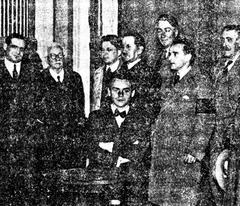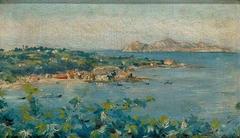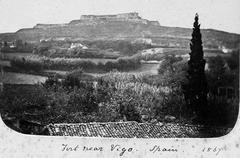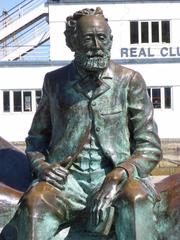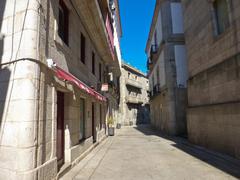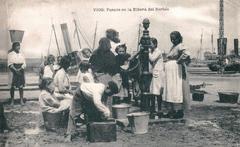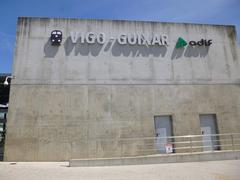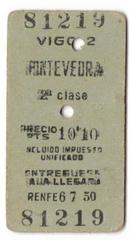
Complete Guide to Muralla de Vigo: Visiting Hours, Tickets, and Historical Sites in Vigo
Date: 04/07/2025
Introduction: The Historic Significance of Muralla de Vigo
Standing on Spain’s scenic Atlantic coast, the Muralla de Vigo (Vigo City Walls) is a testament to the city’s maritime heritage and defensive past. Built in the mid-17th century amidst the turmoil of the Portuguese Restoration War and constant pirate threats, the wall was designed to protect Vigo’s vital harbor and medieval core—what is now the Casco Vello. Today, while most of the original fortifications have disappeared, surviving sections and key structures like the Fortaleza del Castro and Castillo de San Sebastián remain, linking visitors to centuries of resilience and urban evolution (SpottingHistory; Galicia Guide; Ayuntamiento de Vigo).
This detailed guide explores the Muralla de Vigo’s history, architecture, and pivotal events, offering comprehensive visitor information—covering access, tickets, guided tours, and travel tips. Whether you are a history lover or a traveler seeking Vigo’s cultural gems, this article will equip you with all you need to enjoy and understand one of Galicia’s most significant historical sites (Hispanopedia; Turismo de Vigo).
Contents
- Origins and Defensive Needs
- Construction and Architectural Features
- Historical Events and Decline
- Visiting Information: Hours, Tickets, Accessibility
- Nearby Attractions
- Cultural and Architectural Significance
- Preservation and Visitor Experience
- FAQs
- Summary and Travel Tips
- Sources and Further Reading
Origins and Early Defensive Needs
Vigo’s natural harbor has been a focal point for settlement since pre-Roman times, with evidence of the Castro culture dating back to the 2nd century BC (SpottingHistory). However, its exposed coastal position made it vulnerable to repeated raids—first by Vikings and Normans, then by English, Dutch, and Algerian pirates, which hampered the city’s growth and emphasized the need for strong defenses (Galicia Guide).
Construction of the Muralla de Vigo
In 1656, amid the Portuguese Restoration War, King Philip IV ordered the building of Vigo’s defensive wall. Construction began that year and was mainly finished by 1665. The urgency and limited resources led to an irregular design that conformed to the steep slopes of Monte do Castro and the dense medieval urban fabric (Wikipedia - Centro histórico de Vigo; Hispanopedia).
Key features included:
- Six Main Gates: Such as Porta do Pracer, Porta do Sol, and Porta da Gamboa.
- Bastions and Artillery Batteries: Eleven defensive bastions and batteries.
- Integration with Topography: The wall was adapted to the city’s hilly terrain for maximum defensive advantage (SpottingHistory).
The wall was complemented by the Castillo de San Sebastián and the hilltop Fortaleza del Castro, both of which remain prominent landmarks (Hispanopedia).
Historical Significance and Key Events
The Muralla de Vigo played a critical defensive role during periods of conflict:
- Peninsular War (1809): The wall helped locals repel French occupation, celebrated today as the Reconquista de Vigo (Galicia Guide).
- Defending Against Pirates and Corsairs: The fortifications protected the city and its trade from repeated seaborne attacks (Hispanopedia).
- War of Spanish Succession (1702): The Battle of Vigo Bay brought the city’s defenses into European focus.
Despite these roles, the wall was breached during the British attack in 1719 (COPE).
Decline and Demolition
By the 19th century, Vigo’s rapid expansion rendered the walls obsolete. In 1858, most of the Muralla was demolished to accommodate urban growth, though fragments survived—especially near the Casco Vello and the city’s two main castles (Galicia Guide; Wikipedia - Centro histórico de Vigo).
Visiting the Muralla de Vigo: Practical Information
Access and Hours
- Casco Vello and Wall Fragments: Open-access, 24/7, free of charge.
- Fortaleza del Castro: Daily, 10:00 AM–7:00 PM (extended summer hours); check for seasonal changes.
- Castillo de San Sebastián: Accessible year-round; best visited during daylight (Ayuntamiento de Vigo; Turismo de Vigo).
Tickets
- General Access: Free.
- Guided Tours: May require a small fee; book online or at tourist offices (Turismo de Vigo).
Accessibility
- The historic center is pedestrian-friendly but features cobblestones and steep inclines. Fortaleza del Castro requires some uphill walking; limited mobility access is available at the main fortress, but some Casco Vello streets may be challenging (Nomads Travel Guide; Turismo de Vigo).
Guided Tours
- Available from the Vigo Tourism Office and local operators, often in multiple languages. Tours typically last 1–2 hours and provide rich historical context (Discovering Vigo).
Nearby Attractions and Travel Tips
- Best Photo Spots: Fortaleza del Castro for panoramic city and bay views; atmospheric wall fragments in the Casco Vello.
- Other Historic Sites: Concatedral de Santa María, Mercado da Pedra, Plaza de la Constitución, and the Museum of Contemporary Art (MARCO).
- Cultural Events: The annual Fiesta de la Reconquista in March features historical reenactments and celebrations in the old town (historiadegalicia.gal).
- Dining and Shopping: The Casco Vello is filled with tapas bars, cafes, and artisan shops (thetouristchecklist.com).
Cultural and Architectural Significance
The Muralla de Vigo’s irregular, resource-constrained construction reflects the realities of early modern urban defense. Unlike many Spanish city walls, Vigo’s lacked a moat and had thin walls—necessitated by the city’s urgent need for protection and challenging topography (Ayuntamiento de Vigo). Today, its remnants provide vital insight into military architecture and the adaptation of defense to local conditions.
Preservation and Visitor Experience
Local authorities and heritage organizations focus on stabilizing and integrating the remaining wall sections into the urban landscape. Informational panels and guided tours enhance visitor understanding, while conservation efforts prioritize authenticity and sustainable tourism (ICCROM). The Muralla is a living part of Vigo, with many fragments incorporated into homes and businesses, and the site hosting cultural events year-round (Turismo de Vigo).
Frequently Asked Questions (FAQ)
Q: Do I need a ticket to visit the Muralla de Vigo?
A: No. The wall remains and Casco Vello are free; some guided tours may require tickets.
Q: What are the visiting hours?
A: Wall remnants are accessible at any time. Fortaleza del Castro is open daily 10:00 AM–7:00 PM.
Q: Is the site accessible to people with limited mobility?
A: Some areas are steep and cobbled; the main fortress has facilities, but Casco Vello may pose challenges.
Q: Are guided tours available?
A: Yes, through the Vigo Tourism Office and local guides.
Q: What else can I visit nearby?
A: Concatedral de Santa María, Mercado da Pedra, Plaza de la Constitución, and local museums.
Summary and Travel Tips
- Historical Value: The Muralla de Vigo encapsulates the city’s resilience, visible in surviving fragments and street patterns.
- Visitor Experience: Open access, free admission, and a range of guided tours make it easy to explore.
- Best Practices: Wear comfortable shoes, plan for uphill walks, and time visits for morning or late afternoon light.
- Enrichment: Download the Audiala app for immersive audio guides and up-to-date information on events and tours.
Sources and Further Reading
This article was based on authoritative sources, including official city and tourism sites, historical databases, and travel guides. For additional details, see:
- SpottingHistory
- Galicia Guide
- Wikipedia - Centro histórico de Vigo
- Hispanopedia
- Ayuntamiento de Vigo
- Turismo de Vigo
- Discovering Vigo
- Nomads Travel Guide
- ICCROM
- COPE Galicia
- historiadegalicia.gal
- The Tourist Checklist
- Turismo de Vigo Practical Information
- Hikersbay Vigo Tourist Information


